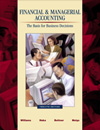Chapter 13 - Summary LO 1 Explain the purpose and usefulness of a statement of cash flows. The purpose of a statement of cash flows is to provide information about the
cash receipts and cash payments of the entity, and how they relate to the entity's
operating, investing, and financing activities. Readers of financial statements
use this information to assess the solvency of a business and to evaluate its
ability to generate positive cash flows in future periods, pay dividends, and
finance growth. LO 2 Describe how cash transactions are classified within a statement of cash flows. Cash flows are classified as (1) operating activities, (2) investing activities,
or (3) financing activities. Receipts and payments of interest are classified
as operating activities. LO 3 Compute the major cash flows relating to operating activities. The major operating cash flows are (1) cash received from customers, (2) cash
paid to suppliers and employees, (3) interest and dividends received, (4) interest
paid, and (5) income taxes paid. These cash flows are computed by converting
the income statement amounts for revenue, cost of goods sold, and expenses from
the accrual basis to the cash basis. This is done by adjusting the income statement
amounts for changes occurring over the period in related balance sheet accounts. LO 4 Explain why net income differs from net cash flows from operating activities. Net income differs from net operating cash flows for several reasons. One reason
is noncash expenses, such as depreciation and the amortization of intangible
assets. These expenses, which require no cash outlays, reduce net income but
do not affect net cash flows. Another reason is the many timing differences
existing between the recognition of revenue and expense and the occurrence of
the underlying cash flows. Finally, nonoperating gains and losses enter into
the determination of net income, but the related cash flows are classified as
investing or financing activities, not operating activities. LO 5 Distinguish between the direct and indirect methods of reporting operating
cash flows. The direct and indirect methods are alternative formats for reporting net cash
flows from operating activities. The direct method shows the specific cash inflows
and outflows comprising the operating activities of the business. Under the
indirect method, the computation begins with accrual-based net income and then
shows adjustments necessary to arrive at net cash flows from operating activities.
Both methods result in the same dollar amount of net cash flows from operating
activities. LO 6 Compute the cash flows relating to investing and financing activities. Cash flows from investing and financing activities are determined by examining
the entries in the related asset and liability accounts, along with any related
gains or losses shown in the income statement. Debit entries in asset accounts
represent purchases of assets (an investing activity). Credit entries in asset
accounts represent the cost of assets sold. The amount of these credit entries
must be adjusted by any gains or losses recognized on these sales transactions. Debit entries to liability accounts represent repayment of debt, while credit
entries represent borrowing. Both types of transactions are classified as financing
activities. Other financing activities include the issuance of stock (indicated
by credits to the paid-in capital accounts) and payment of dividends (indicated
by a debit change in the Retained Earnings account). LO 7 Discuss the likely effects of various business strategies on cash flows. It is difficult to predict the extent to which a business strategy will affect
cash flows. However, an informed decision maker should understand the direction
in which a strategy is likely to affect cash flows - both in the short term
and over a longer term. *LO 8 Compute net cash flows from operating activities using the indirect method. The indirect method uses net income (as reported in the income statement) as
the starting point in the computation of net cash flows from operating activities.
Adjustments to net income necessary to arrive at net cash flows from operating
activities fall into three categories: noncash expenses, timing differences,
and nonoperating gains and losses. Adjustments reconcile net income (accrual
basis) to net cash flows from operating activities. Specific adjustments from
each category are illustrated in the summary analysis of the indirect method
on page 580. **LO 9 Explain the role of a worksheet in preparing a statement of cash flows. A worksheet can be used to analyze the changes in balance sheet accounts other
than Cash and, thereby, determine the related cash flows. In the top portion
of the worksheet, entries are made summarizing the changes in each noncash account.
In the bottom half, offsetting entries are made to represent the cash effects
of the transactions summarized in the top portion. The entries in the bottom
half of the worksheet are classified into the same categories as in a statement
of cash flows. The statement of cash flows then is prepared from the data in
the bottom portion of the worksheet. In this chapter we have discussed the importance of the statement of cash flows
in terms of providing information for investors and creditors. We have seen
how we convert accrual accounting information to cash-based information and
arrange that information so that investors and creditors can better understand
the cash effects of a company's operating, investing, and financing activities.
In the next chapter we take a broader look at financial statement analysis,
including how information from the cash flow statement is combined with information
from the other financial statements, to better understand a company's financial
activities. | 


 2002 McGraw-Hill Higher Education
2002 McGraw-Hill Higher Education